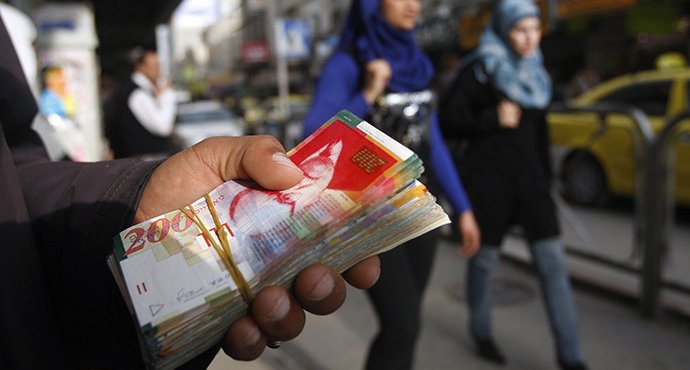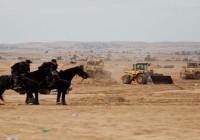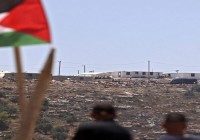PCBS: The Economic forecasts 2017.

Palestinian Economic Performance during 2016
The preliminary estimates for 2016 compiled in accordance with the data available for the first three quarters of the year, and indicators for the fourth quarter 2016 used to estimate the data for that quarter. It should be noted that the data will be revised after the completion of collection of data from relevant sources.
Rise in the Gross Domestic Product (GDP) and GDP per capita during 2016
Preliminary estimates indicated an increase in GDP in Palestine by 3.9% during 2016 compared with 2015; GDP per capita has increased by 1.0% during 2016 compared with 2015.
The largest contributor to the increase in GDP in 2016 was the activity of construction, which rose by 4.7% and the total number of employees increased by 12.3%. The second contributor was the industry activity with a gross value added rising by 4.2% compared to 2015. The total number of employees in the industry activity also increased by 5.3%.
Preliminary estimates of Palestinian labor market indicators
Preliminary estimates indicated an increase in the number of employed persons in the Palestinian labor market by 3.0% in 2016 compared to 2015. The increase was attributed to the high increase in the number of workers in construction, industry and services activities. Preliminary estimates also showed that 12.1% of employed individuals worked in Israel, compared to 11.5% in 2015.
Unemployment rate increased to 27.2% in 2016 compared with 26.2% in 2015.
An increase in exports and imports of goods and services during 2016.
Preliminary estimates of Palestinian foreign trade movements, represented in exports and imports, indicated that the value of exports increase by 6.3% compared to 2015 and the value of imports increased by 7.3% compared to 2015.
Prices
Preliminary estimates, showed that the average of overall consumer prices index in Palestine recorded a stability during 2016 compared with 2015.
Economic Forecasts for 2017
These forecasts were developed based on various scenarios for Palestine, which do not differentiate the West Bank from Gaza Strip despite the gap between them, and in consultation with Advisory committee for economic statistics consists of local economists and academics, in addition to the Ministry of Finance and the Palestinian Monetary Authority. Each scenario took into consideration internal political and economic circumstances for 2017, the blockade imposed upon Gaza Strip, foreign aid, Israeli measures in Palestine, the number of Palestinian workers in Israel and economic and social variables.
1. Baseline Scenario
This scenario is based on the assumption that the economic and political situation in Palestine will remain the same as it was during 2016. It assumes that donor countries will continue to provide financial support for the budget of the State of Palestine (central government). It assumes the continuation of transfer clearance revenues from Israel and improved tax collection efficiency, an increase of government transfers, increased the value of the credit facilities. It assumes that obstacles placed by Israel on the movement of people and goods inside Palestine, between regions, or with neighboring countries, will be the same as in 2016, in addition to natural population growth in Palestine.
Expectations of Base Scenario
Real Sector:
Gross Domestic Product (GDP): It is expected to increase by 3.6% in 2017; the value of GDP per capita is also expected to increase by 0.6%, and the value of gross consumption (private and public) is expected to increase by 3.3%. The value of total investment is expected to increase by 8.0%.
Work and Workers: An increase of 5.2% in the number of employees is anticipated and the unemployment rate is expected to reach 27.2% in 2017.
Fiscal Sector:
A 9.5% increase in the value of government revenues is anticipated as a result of improvements in tax collection, an increase in the value of government expenses by 2.6%, and a decrease of 16.6% of the public budget deficit (central government).
External Sector:
An increase of 4.6% is anticipated in the net current account[5] deficit value of Palestine and an increase of 4.9% in the trade balance deficit value. This is attributed to the expected rise in the value of Palestinian imports by 6.1%, despite the expected increase in value of Palestinian exports by 8.5%, The value of net factor income is expected to increase by 9.2%. And value of gross national income and gross national disposable income will increase by 4.2%, 3.9% respectively.
2. Optimistic Scenario
This scenario is based on an improved political and economic situation due to greater political reconciliation between the West Bank and Gaza Strip, the reconstruction of Gaza Strip, and assistance provided by donor countries to finance the budget of the State of Palestine (central government). It also assumes uninterrupted transfer of clearance revenues and improved tax collection efficiency, with more income tax revenues, domestic value-added tax, and clearance value added tax, increased development expenditure. It also assumes that obstacles placed by Israel on the movement of people and goods inside Palestine, between regions, or with neighboring countries reduced compared with 2016, plus natural population growth in Palestine.
Expectations of the Optimistic Scenario
Real Sector:
Gross Domestic Product (GDP): It is anticipated to increase by 6.7% during 2017 and GDP per capita will increase by 3.7%. It also assumes that gross consumption value (private and public) will increase by 4.7% and the value of total investments will increase by 9.2%.
Work and Workers: An increase of 9.0% in the number of employees is anticipated and the unemployment rate is expected to decrease to 25.2% during 2017.
Fiscal Sector:
An increase in the value of government revenues of 13.5% is anticipated, an increase in the value of government expenses of 5.0%, and a decrease in the public budget deficit value (central government) of 18.3%.
External Sector:
A decrease of 15.0% in the net current account deficit value of Palestine is anticipated and an increase of 2.4% in the trade balance deficit value, due to the increasing the value of Palestinian imports by 5.1% despite the expected increase in the value of exports by 10.9%. The value of net factor income is expected to increase by 22.5%, which will reflect directly on the net current account deficit value due to the increasing number of workers in Israel as a result of the assumption of freedom of movement of people and goods in Palestine. This would increase gross national income value by 8.3%, and gross national disposable income value by 8.6%.
3. Pessimistic Scenario
This scenario accounts for the deterioration in the volatile political and economic situation and in political reconciliation between the West Bank and Gaza Strip. It assumes reduced aid from donor countries to finance the budget of the State of Palestine (central government), an increase in tax evasion, fluctuations in the transfer of clearance revenues, a decline in both revenues of the domestic value added tax and clearance value added tax. It also presumes a decline of income tax revenues. It assumes that obstacles placed by Israel on the movement of people and goods inside Palestine, between regions, or with neighboring countries will increase and the number of workers in Israel will decrease as the result of closures and a halt to negotiations.
Expectations of the Pessimistic Scenario
Real Sector:
Gross Domestic Product (GDP): GDP is expected to decrease by 1.9% during 2017 and GDP per capita will decrease by 4.7%. In addition, gross consumption value (private and public) will increase by 0.5% and the value of total investments will decrease by 7.2%.
Work and Workers: The number of Palestinian employees in Israel is anticipated to decrease by 21.4% which will lead to an increase of the unemployment rate to reach 29.9% during 2017.
Fiscal Sector:
Government revenues value are expected to decrease by 4.5% as a result of Israel freezing a proportion of tax revenues, plus an increase in tax evasion, a decrease in the value of government expenses by 0.6%.
External Sector:
The net current account deficit value of Palestine is anticipated to increase by 21.9% due to an expected increase of 2.3% in the trade balance deficit value following an increase in the value of Palestinian imports by 0.3% and a decrease in the Palestinian exports of 4.1%. Net factor income value is expected to decrease by 9.3% assuming that the number of workers in Israel will decrease and constraints imposed within Palestine will increase. A decrease of 2.7% is anticipated in gross national income value and of 4.2% in the value of gross national disposable income.


